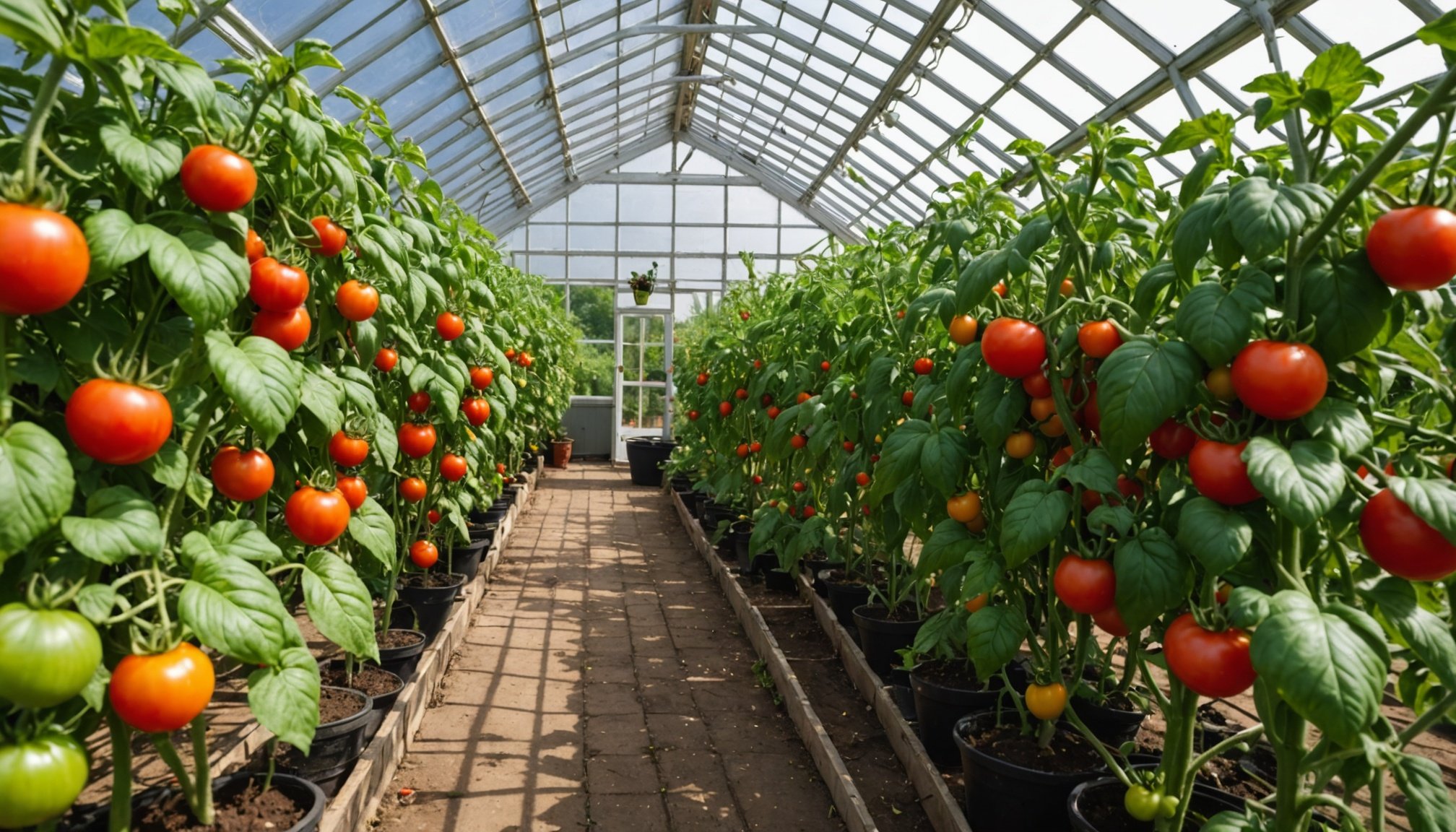The Ultimate Guide to Thriving Tomato Cultivation in Your UK Conservatory
Growing tomatoes in your UK conservatory can be a rewarding and delicious venture, providing you with a steady supply of fresh, home-grown tomatoes year-round. Here’s a comprehensive guide to help you get started and ensure your tomato plants thrive.
Choosing the Right Tomato Varieties
When it comes to growing tomatoes in a conservatory, the right variety can make all the difference. You need varieties that are compact, produce fruit quickly, and can tolerate the warmer and potentially more humid conditions of a conservatory.
In the same genre : Top Organic Strategies for Managing Weeds in Your UK Gravel Pathway
Compact and Dwarf Varieties
For a conservatory, compact or dwarf tomato varieties are ideal. These include:
- ‘Red Robin’: A dwarf variety that produces plenty of small, sweet tomatoes.
- ‘Tumbler’: A trailing variety perfect for hanging baskets.
- ‘Patio’: A compact variety that grows well in pots and produces medium-sized tomatoes.
Early and Fast-Producing Varieties
Early and fast-producing varieties are also a good choice, as they will give you a quicker harvest:
In the same genre : Discover the Best Organic Strategies for Controlling Snails in UK Gardens
- ‘Early Girl’: Known for its early production and medium-sized fruits.
- ‘Sungold’: Produces cherry-sized tomatoes and is a favorite among gardeners for its sweet flavor and early production.
Preparing Your Conservatory
Before you start planting, make sure your conservatory is ready for your tomato plants.
Temperature and Lighting
Tomatoes love warmth and light. A conservatory provides the perfect environment, but you need to ensure it doesn’t get too hot:
- Keep the temperature between 18°C to 24°C (64°F to 75°F) during the day.
- Use shades or blinds to reduce direct sunlight during the hottest part of the day.
Soil and Compost
The soil you use is crucial for healthy tomato plants. Here are some tips:
- Use High-Quality Potting Soil: Look for soil that is well-draining and rich in organic matter.
- Add Compost: Mix in some compost to improve soil fertility and structure.
| Component | Benefits |
|
|---------------------------------------------------------------------------|
| High-Quality Potting Soil | Well-draining, rich in organic matter |
| Compost | Improves soil fertility, structure, and overall plant health |
| Organic Fertilizer | Provides essential nutrients for plant growth |
Planting Your Tomatoes
Planting your tomatoes at the right time and in the right conditions is essential.
When to Sow
In the UK, it’s best to sow tomato seeds indoors in early April. This gives the seedlings a head start before being transferred to the conservatory.
How to Sow
Here’s a step-by-step guide to sowing your tomato seeds:
- Prepare the Seeds: Sow seeds about ¼ inch deep in seed trays or small pots filled with a good quality seed starting mix.
- Provide Warmth: Keep the soil warm (around 20°C or 68°F) until germination.
- Transplant: Once the seedlings have two sets of leaves, transplant them into larger pots or directly into hanging baskets.
Caring for Your Tomato Plants
Once your tomatoes are planted, regular care is necessary to ensure they thrive.
Watering
Tomatoes need consistent moisture, especially when they are producing fruit:
- Check the Soil: Make sure the soil is moist but not waterlogged.
- Avoid Overwatering: This can lead to diseases like root rot and blight.
Feeding
Tomatoes are heavy feeders and benefit from regular fertilization:
- Use Balanced Fertilizer: A balanced fertilizer (e.g., 10-10-10 NPK) can be applied once a month.
- Compost Tea: You can also use compost tea as a natural and organic alternative.
Pruning and Training
Pruning and training your tomato plants can help them grow more efficiently:
- Remove Lower Leaves: Remove lower leaves to prevent soil-borne diseases from splashing up onto the plant.
- Use Supports: Use tomato cages, trellises, or stakes to support the plants as they grow.
| Care Activity | Tips |
|
|-----------------------------------------------------------------------|
| Watering | Keep the soil consistently moist but not waterlogged |
| Feeding | Use balanced fertilizer or compost tea |
| Pruning | Remove lower leaves to prevent diseases |
| Training | Use supports like cages, trellises, or stakes |
| Pest Control | Watch for pests like aphids, whiteflies, and spider mites |
Common Challenges and Solutions
Growing tomatoes indoors can come with its own set of challenges. Here are some common issues and how to address them:
Pests
Pests can be a problem in a conservatory environment:
- Aphids: Use neem oil or insecticidal soap to control aphid infestations.
- Whiteflies: Use yellow sticky traps or neem oil to control whiteflies.
Diseases
Diseases can also affect your tomato plants:
- Blight: Remove infected leaves, improve air circulation, and use fungicides if necessary.
- Root Rot: Avoid overwatering, ensure good drainage, and treat with fungicides if necessary.
Year-Round Production
To enjoy tomatoes year-round, you need to plan your planting schedule carefully.
Succession Planting
Succession planting involves planting new seeds every few weeks to ensure a continuous harvest:
- Plant New Seeds: Every 2-3 weeks, sow new tomato seeds to replace older plants.
Winter Care
During the winter months, your conservatory might be cooler, but you can still grow tomatoes:
- Choose Cold-Tolerant Varieties: Varieties like ‘Red Robin’ can tolerate cooler temperatures.
- Provide Additional Heat: Use heaters or insulation to keep the temperature above 10°C (50°F).
Additional Tips and Tricks
Here are some additional tips to make your tomato growing experience even more successful:
Use Hanging Baskets
Hanging baskets are a great way to maximize space in your conservatory:
- Choose Trailing Varieties: Varieties like ‘Tumbler’ and ‘Sungold’ are perfect for hanging baskets.
Incorporate Companion Plants
Companion plants can help improve the health and productivity of your tomato plants:
- Spring Onions: Plant spring onions around your tomatoes to deter pests.
- Basil: Basil repels pests that target tomatoes and adds flavor to your dishes.
| Companion Plant | Benefits |
|
|---------------------------------------------------------------------------|
| Spring Onions | Deter pests like aphids and other insects |
| Basil | Repels pests, adds flavor to dishes |
| Marigolds | Repel nematodes and other pests |
Growing tomatoes in your UK conservatory can be a fun and rewarding experience. By choosing the right varieties, preparing your conservatory, planting at the right time, and providing the necessary care, you can enjoy a bountiful harvest of delicious home-grown tomatoes year-round.
As gardeners often say, “The key to successful tomato cultivation is consistent care and attention to detail.” With these tips and a little practice, you’ll be enjoying fresh, juicy tomatoes from your conservatory in no time.
Practical Insights and Actionable Advice
- Start Early: Sow your tomato seeds in early April to give them a head start.
- Monitor Temperature: Keep your conservatory at a comfortable temperature for your tomato plants.
- Water Wisely: Ensure the soil is consistently moist but not waterlogged.
- Feed Regularly: Use balanced fertilizers or compost tea to feed your plants.
- Prune and Train: Prune and train your plants to maximize space and promote healthy growth.
By following these guidelines, you’ll be well on your way to growing thriving and productive tomato plants in your UK conservatory. Happy gardening











